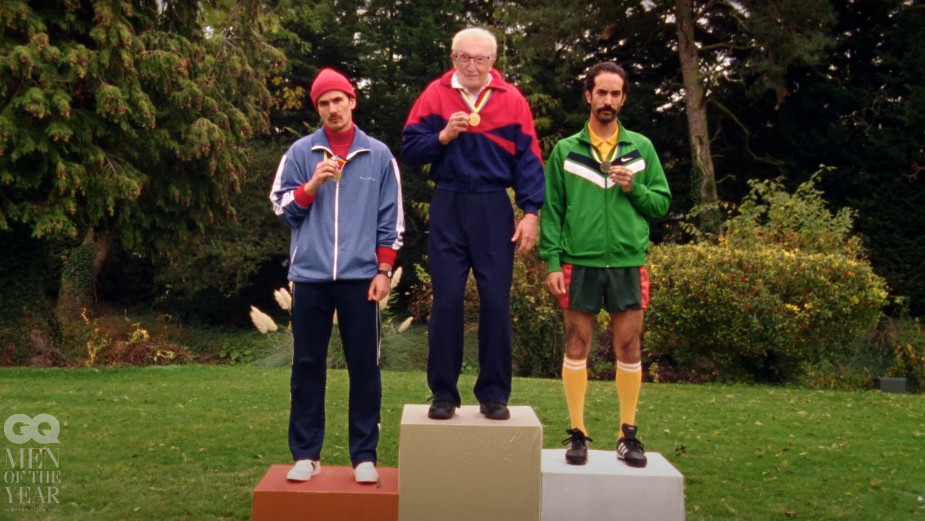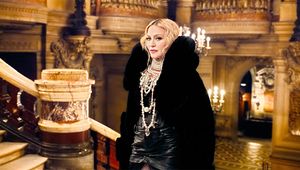
How Do You Make an Award Show Feel Special in a Pandemic?

GQ’s Men of the Year Awards is usually a glitzy showbiz event in London (that’s a city in the real world, if you remember such things). To those of us still under lockdown due to the pandemic, events where people used to don their sharpest get-ups to indulge in a bit of gossip and sip a few drinks seem like a fantasy. But in a year like no other, the men’s lifestyle magazine had plenty of human brilliance to celebrate. So there’s no way it was going to let its yearly hand out of accolades go under the radar, even if the theatre it had booked was spookily empty.
That’s where production company Black Dog Films stepped in, to bring its creative and filmmaking expertise to bear on creating a show that felt like something big - something you’d happily tune into, whether you were wearing a rented tuxedo (they must be going cheap at the moment) or your best tracky bottoms.
“GQ wanted to do something different, and there’s not many companies that can do that,” says global head of Black Dog Martin Roker, ”but as part of the Ridley Scott Creative Group we have the talent, so it was a natural fit for us. We can only look to the future when jumping into a project like this. The collaboration between GQ /BD could only work if we had the same mindset. We wanted to achieve something that could live on for future digital events. We took the origins of an idea and showed how brands can use our creative.”
The form that ended up taking was a show lasting just over an hour, hosted by comedian Jack Whitehall, featuring bespoke pieces of film content made for each of the GQ Men of the Year winners, directed by a variety of Black Dog directors. “From a creative and operational point of view, Black Dog were a joy to work with” said long-time GQ editor Dylan Jones. Where a standard award show might rely on the energy in the room and the dazzling wit (or possibly slight over-inebriation) of the people accepting the awards, this show relied on the creative talents of Black Dog’s directors and producers to make a varied and energetic show.
“We were very ambitious with the vision of the project,” says GQ producer Mateo Notsuke. The goal was to make a show that doesn't feel as “boring and repetitive as the standard structure of awards shows,” so they decided to make it as diverse as possible, mixing as many different creative approaches. The result is a “very refined collection of films that are unique on its own even though they all belong to the same project.”
Coordinating all the different teams on a tight deadline in a world constantly adapting to a pandemic wasn’t easy though.
Black Dog producer Manoela Chiabai stresses the challenge of keeping true to each film’s own creative vision, keeping a solid schedule, wrangling bespoke crew from prep to post for each film, but at the same time aligning it all with a creative arc that they “were still figuring it out what it would be” while it was coming together.
To create something coherent, they decided to shoot the host film last, so they could first see everything they’d created and make sure the host film worked as a “mothership, with all the right jokes, tones, timings, interactions, running order, pace and all assets in hand. It was a lot of moving parts simultaneously coming together,” she says. “Towards the end of the project, it was long sleepless nights for us.”
To coordinate the various directors, all with drastically different films on the go, Mateo says there was a lot of brainstorming over Zoom calls. “We started from the reason why the talent was being awarded and from there we built an idea to tribute and commemorate their achievement. Once a concept was officially decided each Director would take on the idea to construct their vision.”
"Every film was treated as an individual piece with its own curated production team," says Manoela. "Some were shot in film, others in digital, some used mixed media. Toby Dye’s Marcus Rashford film for example was shot with seven different cameras!"
Of course, there was also the backdrop of a pandemic to work with, and it’s impressive that the teams recorded no cases of Covid-19 for a total of 16 productions over a two month window.
“Every shoot was frightening,” says Manoela. “We were shooting [prominent figures] from Marcus Rashford, to Lewis Hamilton and Capt. Sir Tom Moore! We executed every shoot following the exact APA procedure. There was always a Covid officer on the ground with us and for some awardees we had to take a Covid test by contract.”
An added challenge was to make sure the films were in line with the print campaign. With GQ still flying the flag for the unique qualities of print magazines, this was naturally a central aspect. “When possible, if safety, space and time allowed, the video team worked with the photo team together on set,” says Mateo. “As you can imagine this only meant a bigger challenge, especially when some of the talent could only be outside due to weather and health conditions for 10 minutes. We managed to choreograph a workflow where every second we had available was used thoughtfully. We were not only doing a print campaign, we were also doing a press campaign and a social media campaign, so we would often travel with a portable red carpet and step and repeat logo board to create these assets as well. We would normally start with a photo shoot, followed by press shots on a red carpet and short interview for social media. Then talent would move to the set of video and between camera resets and changes the photo team would take shots on the video set for the magazine.”
Every film in the series has its own unique flavour, guided by the personality being celebrated as well as the strengths of the director, so we chatted to some of the Black Dog filmmakers about their respective parts of the project.
Toby Dye
LBB> Your film with Marcus feels very natural and organic. Did your docu-style of shooting play into how you approached the shoot?
Toby> Yes, definitely, but I also wanted the film to be a reflection of Marcus’s campaign for Free School Meals, which felt totally unplanned, impromptu and organic – because it was! So I embraced chaos for our shoot, happily going with whatever happened and with just the lightest touch of direction, but an army of cameras to capture it from every angle and on every format. I think we had around eight cameras running simultaneously, from Alexa, to MiniDV, Super8 and iPhone, with some being operated by seven- year-old children.
Jade Jackman
LBB> Michaela Coel is an inspiration to young creatives and directors. It looked like a lot of fun. How did you find shooting another director?
Jade> Not only is Michaela a brilliant auteur, she is a performer with amazing energy with an enviable dress sense… combine that with her cheekbones and you’ve basically got yourself a dream interviewee.
LBB> How did you decide on the tone of the film?
Jade> Before any event, I always find myself in a chaotic state of excitement… Usually because I can’t decide what to wear or I’m running late, everyone’s missed out on that sense of hype, so I wanted to capture that flurry… the bombardment of texts from friends, last minute snacks, mirror top-ups and outfit checks!
Tom Hingston
LBB> Your film celebrated Lewis Hamilton, in what was a momentous year for him both on and off the track, how was it working with him? Did you have a clear idea of the tone of the film you wanted to shoot?
Tom> It was a great honour to be invited to film him at this moment in his career, but most importantly shine a light on his actions off the circuit. I wanted to show a different side to the image of Hamilton that's so familiar in people’s minds. Both the script and the way it was shot present a very personal portrait of him – one that is centred around emotion, experience and belief. In doing that, it allowed us to isolate this singular gesture –taking the knee – and highlight the power and significance that this has carried, not only within Formula 1, but into the wider world.
Q> You also directed the host film which tied together the narrative. How important was it to keep that “awards show” aesthetic?
Tom> Very. For us, it was imperative that viewers felt like they were being invited to an event – and something that had grandeur and scale. From the outset we wanted the format to feel elevated (albeit virtual)! We had a series of sixteen individual films, each of them very different, so as a means of binding this content together into one narrative we needed to establish an overarching device (or situation) around which to pivot the show. The coliseum presented the perfect location, it offered the opulence and glamour that we were looking for and provided a fitting backdrop for Jack. The main thrust of the show sees him presenting (in isolation) from a grand, empty space – a cinema screen forms the main focus – the perfect device through which to then present our mix of different films... The atmosphere of the space offset against Jack's humour created a compelling dynamic throughout.
Q> You’re no stranger to collaboration. Did you enjoy seeing all the various projects come together?
Tom> Immensely. It was a terrific roster of talent, and this was the first time that the awards had taken the form of a streamed event – so collectively you’re creating a whole new format, which for everyone involved was really exciting. It’s a great case-study for collaboration – and essentially forms a blueprint for future events.
Micaela McLucas
LBB> The GQ awards were a celebration of some amazing talents, but it was also a collaborative first from GQ and Black Dog. Each film was totally different. What did you try and bring to yours with Daniel?
Micaela> I have known Daniel’s work for many years now from covering his collections during Fashion Week, so I know how passionate and hardworking he is, and I really wanted to find a way to highlight that in this film. My priority is always getting the vibe going on set and despite all the limitations of shooting during the pandemic, I was really lucky to have the support from Black Dog to explore my vision and make it all happen.
Tom Dream
LBB> Was teaming up with Patrick Hutchinson to tell his story a good fit for you?
Tom> With this project I was keen to make sure that Patrick’s positive work and character was reflected in the filmmaking process, and that he could use the film and GQ’s platform as an opportunity to talk about his organisation UTCAI and the amazing work they are doing as a collective. With the involvement of Margate based organisation People Dem Collective, and the support of Black Dog Films, we were able to give opportunities to young people in Margate to get valuable experience on set, and become a part of the production process, with questions to Patrick being asked by Kane McArthur and images being taken by Sterling Chandler, which have since been printed in GQ’s 2020 Men of the Year issue. This to me felt like we were creating intrinsic value in the process.
LBB> How did you decide on the tonal feel for the film?
Tom> In general I like to let the tone of any film I’m directing be guided as much as possible by the character and energy of the protagonist. Patrick is an extremely modest and thoughtful individual, with a great deal of wisdom to share. As a result the film took on a reflective sort of tone; and he became this centre of peace and compassion amidst the chaos and tension of the protest archive footage. As a result it was Patrick’s grounded demeanour and quiet strength that guided the tone of the film. It was this that informed the editing style and original music composition by Steve Pringle.
LBB> As a director, do you feel it's important to also make work with purpose?
Tom> I think the events of this year have definitely put a lot of things in perspective, and it feels like an important time to think very carefully about not only the sort of work we make, but how we make it too. It’s definitely important to me to make work with purpose, but that doesn’t necessarily mean it has to carry some profound political message. I think what’s most important is making honest work. That can be silly or surreal or just for joy or escapism, or it can be more literal or explicit if the subject demands it. It’s important to me to exercise both sides of my brain and maybe a balance between the two creates the best outcome.
Greg Barnes
LBB> Humour was a big part of your film, which can be hard to shoot naturally, especially unscripted? What was the idea behind the creative and how did you execute it?
Greg> A large feature of the Bond canon is a gruelling interrogation scene, and it felt apt to put Lashana in the hot-seat.GQ came to me with the brief that we would hook Lashana up to a machine as an extension of their Lie Detector led interview series under the Vanity Fair label.
It was key that we built a genuinely tense atmosphere, taking inspiration from the dark and sometimes clinical lairs of infamous Bond villains - if Lashana was too relaxed the interview wouldn’t work. The same approach went for the questions - they needed to be high stakes, ones she would genuinely want to avoid or smooth over. Then - the lie detector itself; it was functional but unreliable at best, and yet Lashana had no reason to believe it was nothing but fully operational, so we used that to our advantage to really wind Lashana up - sometimes I could manipulate the machine into indicating a lie simply to get an incredulous reaction from her.
Ultimately, we did as much as we could to throw Lashana into the drama and tension of a real interrogation - where the comedy would come from her genuine reactions and nerves around being hooked up to the lie detector, regardless of its reliability. It helps massively that Lashana was a great sport; she really embraced the concept and had a good laugh doing it - and so did we.













